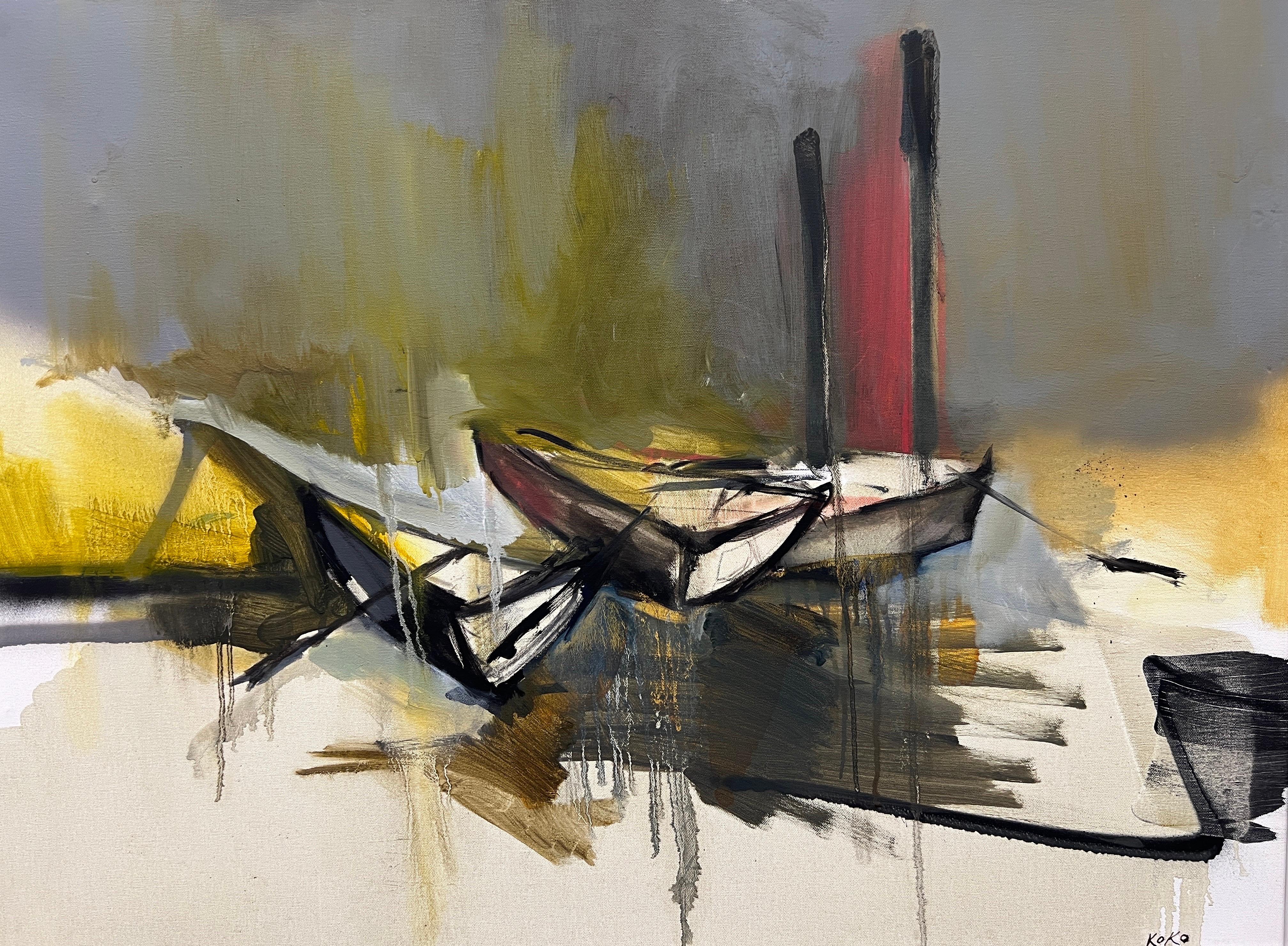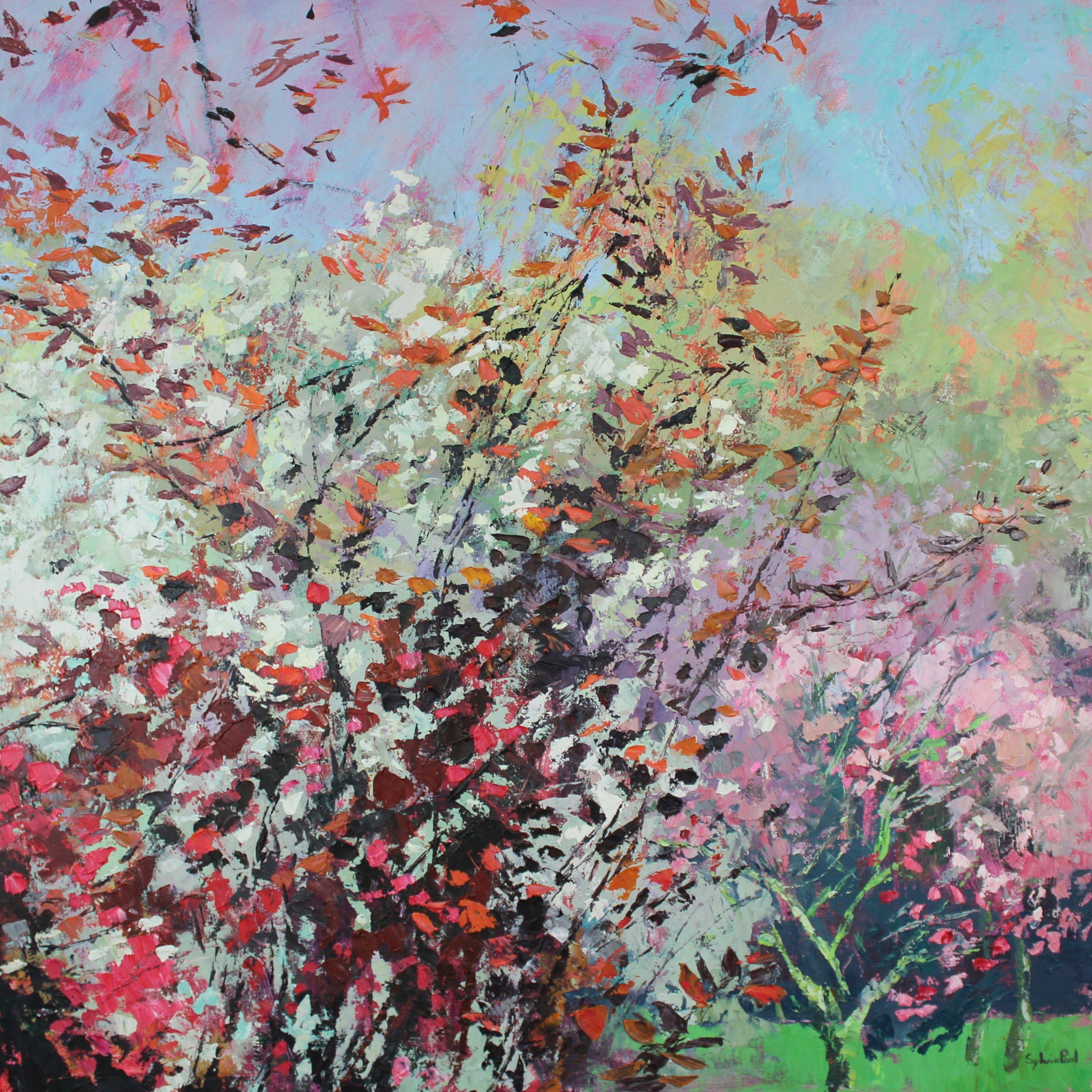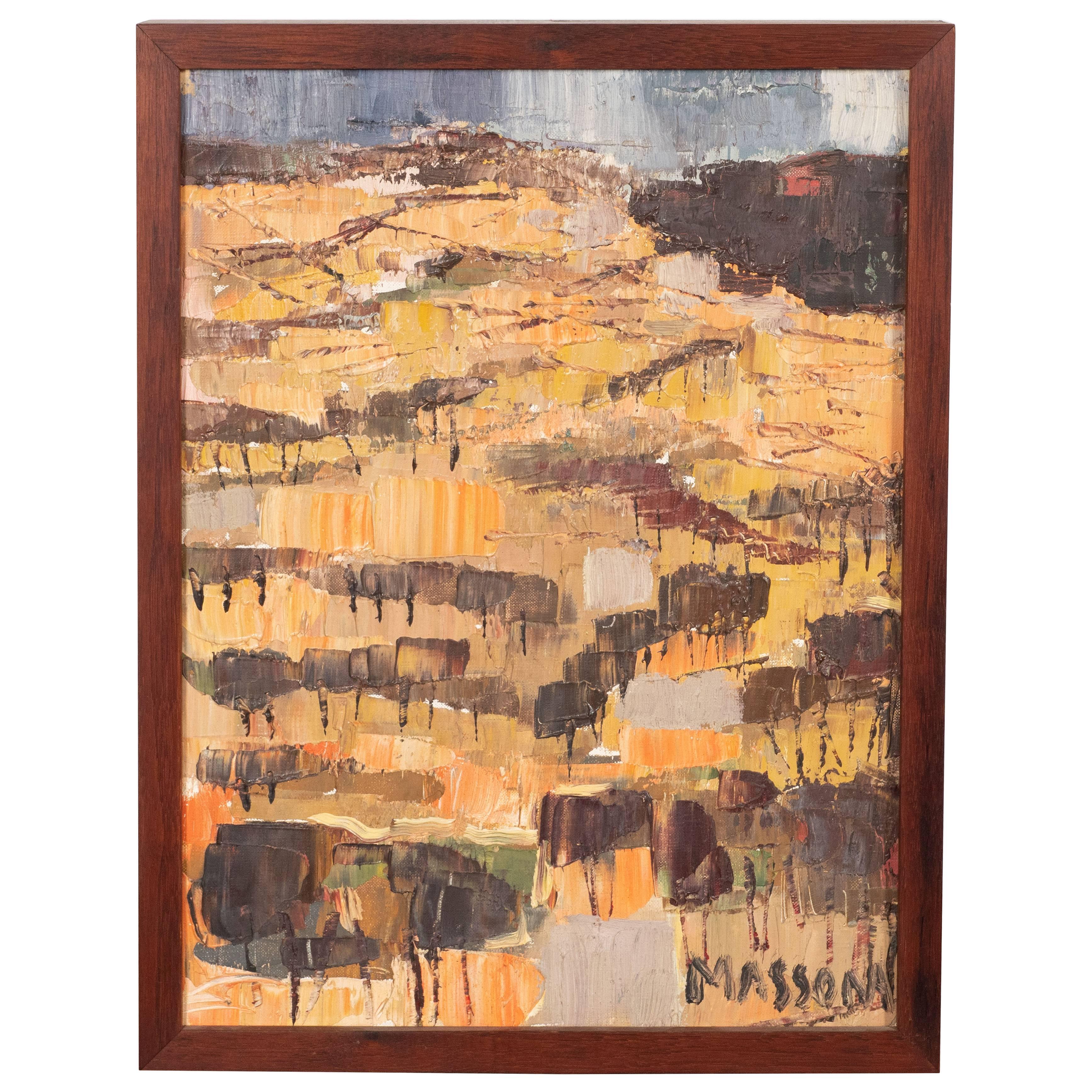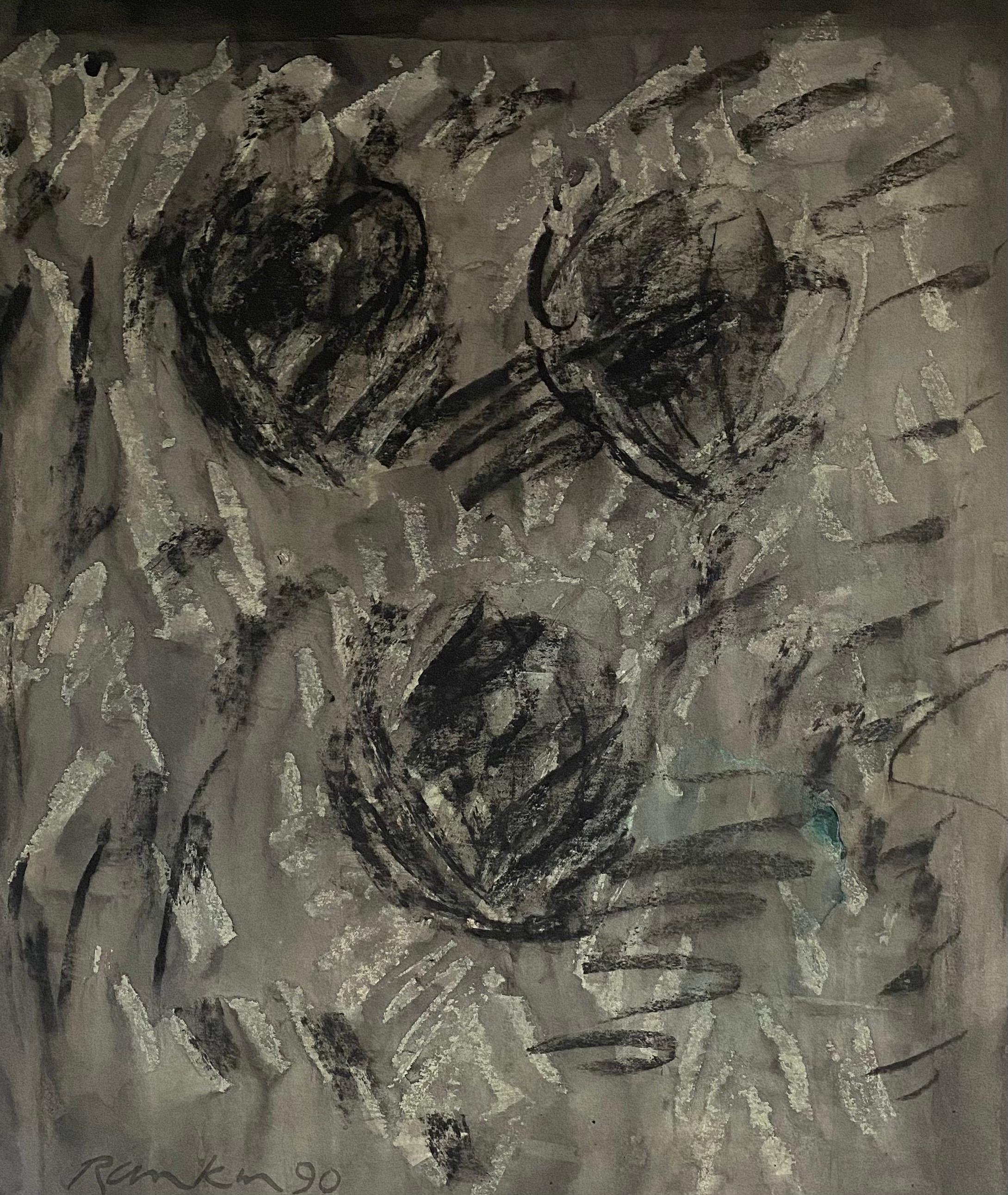Items Similar to Joan Kahn Rome Vibrant Bold Color Abstract Expressionist Modernist Oil Painting
Want more images or videos?
Request additional images or videos from the seller
1 of 15
Joan KahnJoan Kahn Rome Vibrant Bold Color Abstract Expressionist Modernist Oil Painting1987
1987
About the Item
Oil paint on heavy tar paper.
Hand signed and dated verso.
Joan Kahn (USA 1953-) grew up in New York City; Princeton, New Jersey; and Vermont; in an environment that patronized the arts. At home her father, a professor, and mother, a state economist and homemaker, collected nineteenth and twentieth century drawings and prints, Middle eastern rugs, and ceramics, pewter, and old tools. Her grandfather, Max Westfield, was an academically trained portrait painter and her great uncle was a well-known gallery owner and art dealer in pre-World War II Germany. One of the influential experiences of Joan’s youth was visiting her grandfather in his studio in Tennessee where the family had first immigrated.
Growing up near New York, and spending a year in Paris during high school, provided formative visits to museums and galleries. Joan was academically talented in grade and high school, but after her father’s death during her first years at university she found herself concentrating on studio and history of art. It was a subject above others absorbed and concentrated her focus.
Influential in Joan’s development and later work are the historic movements of the Bauhaus and Modernist design and architecture, geometric art and design of diverse cultures, Color Field Painting. Many artists have had a impact on her work, such as Paul Klee, Piet Mondrian, Sonia Delaunay, Mark Rothko, Ad Reinhardt, Antoni Tapies, David Smith, John McLaughlin, Tony Smith, Louise Nevelson, Robert Mangold, Ellsworth Kelly, Agnes Martin, Valerie Jaudon, Jasper Johns, James Turrell, Robert Irwin, Vija Celmins, Caio Fonseca, Peter Halley, Ed Moses, Juan Usle, and Nancy Haynes. After receiving three degrees from the University of Wisconsin in studio art with a minor concentration in art history, Joan worked for the National Endowment for the Arts for five years in the Artist-in-Residence Program in schools in the Midwest and on the east coast of the United States. Subsequently she became an art professor in Rome, Italy, for the next half decade, during which time she maintained a studio practice and exhibited solo and in groups. Becoming a mother in Italy, and raising a son, has been one of the great pleasures of her life.
For the past twenty-five years Joan Kahn has based her life as an art professor and artist in Altadena, California, where she maintains a painting and drawing studio surrounded by nature and a thriving garden. Joan listens to jazz in the studio and at home and attends live concerts as often as possible. She spends part of each year in Barnard, Vermont, on family property where she paints in the studio, swims in the pond, and walks in the woods.
Joan currently teaches at Art Center College of Design, Mt. San Antonio College, and Pasadena City College. Her paintings are exhibited nationally, most often in galleries on the east and west coast of the United States.
- Creator:Joan Kahn (1953)
- Creation Year:1987
- Dimensions:Height: 38 in (96.52 cm)Width: 27 in (68.58 cm)
- Medium:
- Movement & Style:
- Period:
- Condition:good. minor wear.
- Gallery Location:Surfside, FL
- Reference Number:1stDibs: LU3827499612
About the Seller
4.9
Platinum Seller
These expertly vetted sellers are 1stDibs' most experienced sellers and are rated highest by our customers.
Established in 1995
1stDibs seller since 2014
1,546 sales on 1stDibs
Typical response time: 1 hour
- ShippingRetrieving quote...Ships From: Surfside, FL
- Return PolicyA return for this item may be initiated within 3 days of delivery.
More From This SellerView All
- Australian Abstract Expressionist Gouache Painting Charcoal on Shaped PaperBy David RankinLocated in Surfside, FLDavid Rankin American (b. 1946) Untitled (Black on gray) (1990) Gouache and charcoal on paper signed lower left 19 x 15 inches Rankin is a New York-based, British-born Australian post-war and contemporary artist known for his expressionistic abstract paintings. His work can be categorized by his use of quick, loose brushstrokes, reminiscent of scribbles on a page. Rankin works predominantly in oil painting and acrylic on canvas, but also works with paper, prints, sculptures and ceramics. Rankin has held over 100 one-person exhibitions in cities across the world, including New York, London, Paris, Beijing, Mexico, Vienna, Berlin and Cologne, as well as all over Australia. Represented in many of the world’s leading public and private collections and museums, David Rankin’s work is featured in Australia’s leading institutions, including the National Gallery of Australia, Art Gallery of New South Wales, National Gallery of Victoria and Queensland Art Gallery. David Rankin was born in Plymouth, Devon, England in 1946 then emigrated to Australia with his family in 1948. He spent his childhood in the 1950s in the semi-rural Port Hacking region South of Sydney and his teenage years in country New South Wales, from Hay, Wagga Wagga and Albury in the South to Bourke and Brewarrina in the North. Rankin is self-taught, developing his techniques and ideas in the outback towns of his youth. He was inspired by the greats from Leonardo da Vinci to Paul Klee as well as being influenced by the history of Buddhism and Asian art. In his travels before he arrived in Sydney in 1967 he developed a concept of what he wanted to achieve as an Australian artist. His dream was to express the anima, the life spirit or the essence of God in all nature. As an Australian artist he believed could bring the elements of Western Art together with an understanding and love for the cultures of Asia and the Australian Aborigine. He also felt that as Australia was closer to Asia than Europe it made sense to think about the art of Indian, Chinese and Japanese artists, and that one could not be an authentic articulate Australian artist without a love and respect for the artistic and spiritual expressions of the various Aboriginal artists, peoples and cultures. His work combined elements of Abstract Expressionist painting with Jewish and Aboriginal influences. In 1979 his first wife, Jennifer Mary Roberts (née Haynes) died. Rankin subsequently met his current wife Lily Brett, whose own life was etched by tragedy with her parents being survivors of the Holocaust. She too migrated to Australia as a child after the Second World War in 1948. The artist recounts that his empathy for Lily and the pity for his first wife's death fused into what he calls "the dark blessing of my life." The darkness was transformed into images. The author Dore Ashton writes that the events of 1979 and the fire which ravished his studio in 1997 and burnt his art works and many personal possessions, had a profound impact on his work. Having personal life experiences as his subject matter, Rankin's paintings contemplate these things. For example, his Jerusalem series followed a trip to Jerusalem in 1988, which then led to his Golgotha works. His travels to the Australian, American and Mexican deserts became the subject matter for many of his canvases, such as Ridge – Mungo, Golden Prophecy – San Antonio, Grey Sonora Landscape and then led to his Witness Series. From the fire in his studio he then painted Buddha and Flames. He illustrated two books by Lily Brett on the holocaust and explored the theme further in his huge work The Drowned and The Saved from a book by Primo Levi of the same name. Through Brett he encountered Jewish mythology and painted judaica imagery, Black Menorah...Category
1990s Abstract Expressionist Abstract Paintings
MaterialsCanvas, Oil
- Joan Kahn Rome Vibrant Bold Color Abstract Expressionist Modernist Oil PaintingLocated in Surfside, FLOil paint on heavy tar paper. Hand signed and dated verso. Joan Kahn (USA 1953-) grew up in New York City; Princeton, New Jersey; and Vermont; in an envir...Category
1980s Abstract Expressionist Abstract Paintings
MaterialsOil
- Australian Abstract Expressionist Oil PaintingBy David RankinLocated in Surfside, FLDavid Rankin is a New York-based, British-born Australian post-war and contemporary artist known for his expressionistic abstract paintings. His work can be categorized by his use of quick, loose brushstrokes, reminiscent of scribbles on a page. Rankin works predominantly in oil painting and acrylic on canvas, but also works with paper, prints, sculptures and ceramics. Rankin has held over 100 one-person exhibitions in cities across the world, including New York, London, Paris, Beijing, Mexico, Vienna, Berlin and Cologne, as well as all over Australia. Represented in many of the world’s leading public and private collections and museums, David Rankin’s work is featured in Australia’s leading institutions, including the National Gallery of Australia, Art Gallery of New South Wales, National Gallery of Victoria and Queensland Art Gallery. David Rankin was born in Plymouth, Devon, England in 1946 then emigrated to Australia with his family in 1948. He spent his childhood in the 1950s in the semi-rural Port Hacking region South of Sydney and his teenage years in country New South Wales, from Hay, Wagga Wagga and Albury in the South to Bourke and Brewarrina in the North. Rankin is self-taught, developing his techniques and ideas in the outback towns of his youth. He was inspired by the greats from Leonardo da Vinci to Paul Klee as well as being influenced by the history of Buddhism and Asian art. In his travels before he arrived in Sydney in 1967 he developed a concept of what he wanted to achieve as an Australian artist. His dream was to express the anima, the life spirit or the essence of God in all nature. As an Australian artist he believed could bring the elements of Western Art together with an understanding and love for the cultures of Asia and the Australian Aborigine. He also felt that as Australia was closer to Asia than Europe it made sense to think about the art of Indian, Chinese and Japanese artists, and that one could not be an authentic articulate Australian artist without a love and respect for the artistic and spiritual expressions of the various Aboriginal artists, peoples and cultures. His work combined elements of Abstract Expressionist painting with Jewish and Aboriginal influences. In 1979 his first wife, Jennifer Mary Roberts (née Haynes) died. Rankin subsequently met his current wife Lily Brett, whose own life was etched by tragedy with her parents being survivors of the Holocaust. She too migrated to Australia as a child after the Second World War in 1948. The artist recounts that his empathy for Lily and the pity for his first wife's death fused into what he calls "the dark blessing of my life." The darkness was transformed into images. The author Dore Ashton writes that the events of 1979 and the fire which ravished his studio in 1997 and burnt his art works and many personal possessions, had a profound impact on his work. Having personal life experiences as his subject matter, Rankin's paintings contemplate these things. For example, his Jerusalem series followed a trip to Jerusalem in 1988, which then led to his Golgotha works. His travels to the Australian, American and Mexican deserts became the subject matter for many of his canvases, such as Ridge – Mungo, Golden Prophecy – San Antonio, Grey Sonora Landscape and then led to his Witness Series. From the fire in his studio he then painted Buddha and Flames. He illustrated two books by Lily Brett on the holocaust and explored the theme further in his huge work The Drowned and The Saved from a book by Primo Levi of the same name. Through Brett he encountered Jewish mythology and painted judaica imagery, Black Menorah...Category
1990s Abstract Expressionist Abstract Paintings
MaterialsCanvas, Oil
- Joan Kahn Indigo Denim Blue Color Abstract Expressionist Modernist Oil PaintingLocated in Surfside, FLOil paint on heavy paper. (this might possibly be acrylic paint) This does not appear to be signed. Joan Kahn (USA 1953-) grew up in New York City; Princeto...Category
1980s Abstract Expressionist Abstract Paintings
MaterialsOil
- Australian American D. Rankin Abstract Expressionist Oil Painting Rocky HillsideBy David RankinLocated in Surfside, FLDavid Rankin, American (b. 1946) Rocky Hillside, (1990) Oil on paper Hand signed lower right, signed and titled verso. 30 x 22 1/2 inches David Rankin is a New York-based, British-born Australian post-war and contemporary artist known for his expressionistic abstract paintings. His work can be categorized by his use of quick, loose brushstrokes, reminiscent of scribbles on a page. Rankin works predominantly in oil painting and acrylic on canvas, but also works with paper, prints, sculptures and ceramics. Rankin has held over 100 one-person exhibitions in cities across the world, including New York, London, Paris, Beijing, Mexico, Vienna, Berlin and Cologne, as well as all over Australia. Represented in many of the world’s leading public and private collections and museums, David Rankin’s work is featured in Australia’s leading institutions, including the National Gallery of Australia, Art Gallery of New South Wales, National Gallery of Victoria and Queensland Art Gallery. David Rankin was born in Plymouth, Devon, England in 1946 then emigrated to Australia with his family in 1948. He spent his childhood in the 1950s in the semi-rural Port Hacking region South of Sydney and his teenage years in country New South Wales, from Hay, Wagga Wagga and Albury in the South to Bourke and Brewarrina in the North. Rankin is self-taught, developing his techniques and ideas in the outback towns of his youth. He was inspired by the greats from Leonardo da Vinci to Paul Klee as well as being influenced by the history of Buddhism and Asian art. In his travels before he arrived in Sydney in 1967 he developed a concept of what he wanted to achieve as an Australian artist. His dream was to express the anima, the life spirit or the essence of God in all nature. As an Australian artist he believed could bring the elements of Western Art together with an understanding and love for the cultures of Asia and the Australian Aborigine. He also felt that as Australia was closer to Asia than Europe it made sense to think about the art of Indian, Chinese and Japanese artists, and that one could not be an authentic articulate Australian artist without a love and respect for the artistic and spiritual expressions of the various Aboriginal artists, peoples and cultures. His work combined elements of Abstract Expressionist painting with Jewish and Aboriginal influences. In 1979 his first wife, Jennifer Mary Roberts (née Haynes) died. Rankin subsequently met his current wife Lily Brett, whose own life was etched by tragedy with her parents being survivors of the Holocaust. She too migrated to Australia as a child after the Second World War in 1948. The artist recounts that his empathy for Lily and the pity for his first wife's death fused into what he calls "the dark blessing of my life." The darkness was transformed into images. The author Dore Ashton writes that the events of 1979 and the fire which ravished his studio in 1997 and burnt his art works and many personal possessions, had a profound impact on his work. Having personal life experiences as his subject matter, Rankin's paintings contemplate these things. For example, his Jerusalem series followed a trip to Jerusalem in 1988, which then led to his Golgotha works. His travels to the Australian, American and Mexican deserts became the subject matter for many of his canvases, such as Ridge – Mungo, Golden Prophecy – San Antonio, Grey Sonora Landscape and then led to his Witness Series. From the fire in his studio he then painted Buddha and Flames. He illustrated two books by Lily Brett on the holocaust and explored the theme further in his huge work The Drowned and The Saved from a book by Primo Levi of the same name. Through Brett he encountered Jewish mythology and painted judaica imagery, Black...Category
1990s Abstract Expressionist Abstract Paintings
MaterialsPaper, Oil
- Large Modernist French Abstract Expressionist Colorful Bird Painting Roger LersyBy Roger LersyLocated in Surfside, FLRoger Lersy, French (1920 - 2004) Oil on canvas Signed, R. Lersy, dated 1961 lower right Measuring 35 X 31 Matted and framed. sight 26 X 21.5 Roger Lersy was born in Paris, France 1920, in the rough neighborhood surrounding Place Pigalle. His youth was marked by extreme poverty. Lersy studied art and music at the École des Arts Apppliqués. He was a painter, lithographer and musician-composer He belongs to the École de Paris and was a member in the movement of the Young Painting. By 1946, when he first exhibited in Paris, Lersy became one of the founders of the School of Paris’ New Graphic School. Lersy received the Prix des Amateurs d’Art in 1953, the Shell Prize in 1954 and the Grand Prize of the City of Marseilles in 1953. Lersy could be defined as a Baroque expressionist. For Bernard Dorival, Roger Lersy is along with Gabriel Dauchot, Jean Commère and Raymond Guerrier among "the most noted champions of this expressionism which is part of the continuation of Bernard Buffet's miserabilism". Famous works: New Year's Eve , Aubusson tapestry of the Manufacture des Gobelins , Permanent Mission of France to the United Nations , One Dag Hammarskjöld Plaza , New York . Venice , bridges , watercolor, 1963 (theme of the Roger Lersy exhibition, Chicago). The poppy , original lithograph, Imprimerie Bellini, 1978, collection of the Cabinet des estampes , BNF . Still life at the pedestal table , oil on canvas, Jonzac town hall. Lohengrin , oil on canvas, Versailles Administrative Court of Appeal. Portrait of the painter Tony Agostini , drawing. Series Eiffel Tower. Stained glass: Saint-Laurent Church, Longlaville ( Meurthe-et-Moselle ), 29 stained glass windows. Musical works: Stained glasses for clarinet , saxophone, cello and percussion , creation in the church of Longlaville, 1972. Three pieces for two waves Martenot : 1. Scum of dream, 2. Scare and jubilation. Malicious connivance, sheet music Editions A. Leduc, Paris, 1979. Work for trumpet and piano , published by Éditions G. Billaudot, Paris, 1984. Five pieces for piano , scores published by G. Billaudot, Paris, 1989. Five preludes for piano and alto saxophone , scores at Éditions Combre, premiere at Flâneries musicales de Reims , 1993. In memory of Chagall , piece for flute and percussion , recording of Duo Hyksos (Henri Tournier, flute and Michel Gastaud, percussion) in 1995. Preface in black and yellow for horn and piano , score at Éditions Combre, Arc-en-ciel collection, 2000. Soundtracks: Diatomées Note 4 , 19 , film by Jean Painlevé...Category
1960s Abstract Expressionist Abstract Paintings
MaterialsOil, Acrylic, Canvas
You May Also Like
- Contemporary boats, Boats Astore.By KOKO HOVAGUIMIANLocated in La Canada Flintridge, CABoats Astore," an exquisite masterpiece crafted by the talented artist Koko Hovagumian, invites viewers into a serene maritime scene where creativity and subtlety converge. The title...Category
2010s Abstract Expressionist Abstract Paintings
MaterialsOil
- Drip SplatterBy Darius YektaiLocated in Sag Harbor, NYA splatter paint composition on resin, reminiscent of Jackson Pollock who lived and worked a short drive away from Yektai's studio. However, Yektai makes this abstract expressionist ...Category
21st Century and Contemporary Abstract Expressionist More Art
MaterialsCanvas, Resin, Oil
- Hear the Birds Sing-original abstract floral landscape painting-contemporary ArtBy Sylvia PaulLocated in London, ChelseaIn "Hear The Birds Sing" by Sylvia Paul, the artist invites viewers into a vibrant spring garden alive with the melody of chirping birds. This original landscape painting, executed i...Category
21st Century and Contemporary Abstract Expressionist More Art
MaterialsCanvas, Oil
- Sound Vibration, Original Abstract Painting, Colourful Artwork, Pollock StyleBy Allan StorerLocated in Deddington, GBSound Vibration by Allan Storer is a brightly coloured abstract artwork inspired by the works of Jackson Pollock, Mark Rothko and Gerhard Richter. Allan Storer is an artist sold wi...Category
21st Century and Contemporary Abstract Expressionist Abstract Paintings
MaterialsCanvas, Oil
- Abstract HilltopLocated in New York, NYThis stunning and sophisticated oil on canvas painting, entitled "Abstract Hilltop" was realized in the United States, circa 1960. It features an array of color blocks in tones of ch...Category
1960s Abstract Expressionist Abstract Paintings
MaterialsOil
- AnticipationBy Richard LytleLocated in Milford, NHThis large exceptional abstract was painted by American artist Richard Lytle (born 1935). Lytle was born in Albany, New York, studied at the Cooper Union School of Art and the Yale University School of Art, where he received a BFA and MFA. He was included in the Museum of Modern Art’s Sixteen Americans exhibition in 1959. He began teaching in 1960 at Yale, which began a forty year career as a teacher, professor, and dean. He has had numerous one-man and group exhibitions, and he received the Augustus Saint...Category
Mid-20th Century Abstract Expressionist Abstract Paintings
MaterialsCanvas, Oil
Recently Viewed
View AllMore Ways To Browse
Joan Of Art
World War Ii German
Joan Wood
By Kahn
Modernist Abstract Rug
Italy Garden Oil Painting
Abstract Pond
Italian Ceramics Abstract
Joan Johns
Oil Paintings Nineteenth Century
Oil Painting Italy Coast
Oil Paintings Of Italy Coast
Oil Paintings With Jazz
Middle Eastern Paintings
Midwest Oil
Expressionist Klee
Old Vintage Tool
Old Tools Vintage





